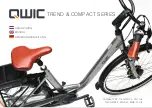
29
EN
Damage on a carbon frame is not always vis-
ible. If your bike is involved in a crash or acci-
dent, have the carbon frame inspected by your
FLYER dealer.
• Are the seat, seat post, stem and handlebars
still in their correct positions? When this is not
the case, do NOT move the components back
from their changed position before loosening
the relevant screw connection. It is essential to
adhere to the prescribed fastening torque. Val-
ues and information are provided in the “Tech-
nical Data” and in the “Quick release fastener”
chapter (12.1).
• Check whether both wheels are correctly and
firmly attached to the frame and fork, that both
the front and rear wheels rotate freely and that
the rim runs straight past the brakes without
snagging. The tyres must not touch the brakes.
• Check that both brakes are operating fully.
•
Do not set off again without ha ing checked
that the chain is sitting securely on both the
front chain wheel and rear sprockets. It must
be engaged fully with the cogs. f you set off
and the chain umps off a cog you may fall, at
the risk of very severe injury.
• Check whether the display of the FLYER
e-bike shows a fault message or a warning.
Do not drive your FLYER when a warning is
displayed. Immediately contact your FLYER
specialist retailer.
• Check that the display and the battery are un-
damaged. Do not ride your FLYER if there are
any noticeable changes (cracks, scratches,
etc. . Ha e all parts and functions first checked
by your FLYER specialist retailer.
If you notice any changes to your bicycle, DO
NOT continue cycling. Do not retighten any loose
parts without first checking them and always use
a torque wrench. Take the FLYER to your FLYER
specialist retailer, describe the fall to them and
have the bicycle checked out!
There is a risk that humidity or water
may penetrate the motor if the housing
of your battery is cracked. This may lead
to short circuits or electrical shocks. Im-
mediately stop using the battery in this
case and contact your FLYER specialist
retailer. Do not charge the battery.
12. Adjusting the
bike to the rider
Installing pedals
Always have your pedals installed or changed by
your FLYER specialist retailer, and feel free to ask
Chapter 19. All components of the
FLYER are safety-related and have
a specific ser ice life. Exceeding this
ser ice life can lead to unexpected
failure of the components. This can
lead to falls and serious injury.
2. The vehicle is subject to wear and
high stress as are all other mechan-
ical components. Depending on the
degree of stress imposed on them,
different materials and parts may re
-
act differently in terms of wear and
fatigue. A part may suddenly fail and
cause injuries to the driver when its
designed ser ice life is exceeded.
Any kind of cracks, scratches or col-
our changes in high-stress areas are
an indicator that the service life of the
component has been exceeded and
that it should be replaced. This is es-
pecially true for FLYER bikes with a
carbon frame. Damage on a carbon
frame is not always visible. If your
FLYER bike with a carbon frame falls
over or sustains damage during trans-
port, have the carbon frame inspected
by your FLYER dealer.
1. It is essential to have your FLYER
checked by a FLYER specialist retail-
er after a fall or when your FLYER has
fallen over! Many components cannot
be safely repaired and components
may be damaged in a way that you
cannot recognise.
2. Do not forget to take a high-quality
bike lock with you on the ride so you
can park and lock your FLYER to an
immovable object. Separately lock
the components that are fastened
with quick release fasteners (e.g. the
front wheel) as required. This will pre-
vent theft of these add-on parts.
11.
After a fall
Have the vehicle and all components checked
for changes, damage, firm attachment and cor
-
rect function by a FLYER specialist retailer. This
may, in particular, include dents and cracks in the
frame and fork, bent components and parts such
as the handlebars or a shifted or turned seat. In-
spection by a FLYER specialist retailer must cov-
er the following main points:
• Carefully check the frame and fork. Deforma-
tions can usually be detected when looking at
surfaces from different angles. This is especial
-
ly true for FLYER bikes with a carbon frame.















































